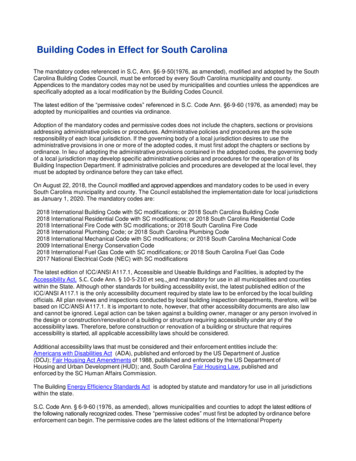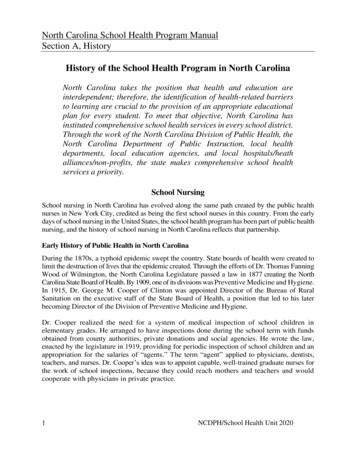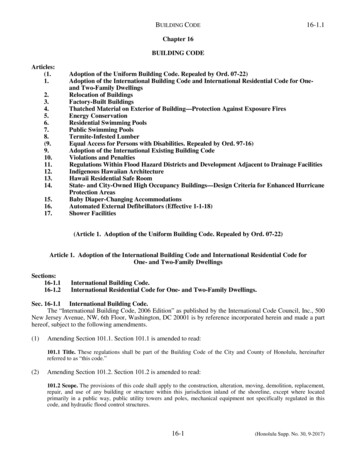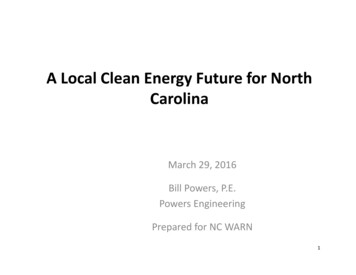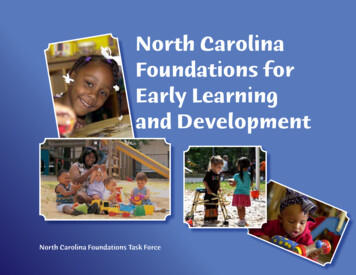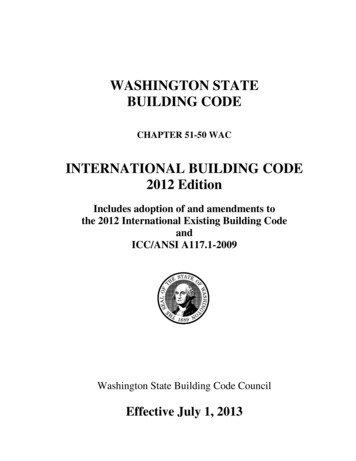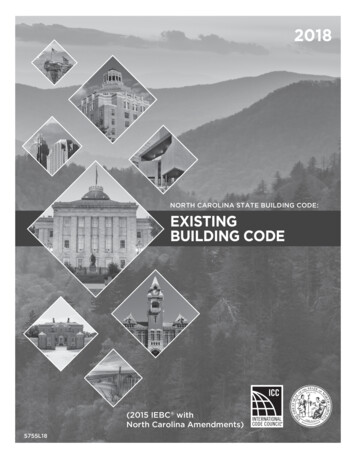
Transcription
2018NORTH CAROLINA STATE BUILDING CODE:EXISTINGBUILDING CODE(2015 IEBC withNorth Carolina Amendments)5755L18
2018 North Carolina Existing Building CodeFirst Printing: May 2018ISBN: 978-1-60983-834-8COPYRIGHT 2018byINTERNATIONAL CODE COUNCIL, INC.ALL RIGHTS RESERVED. This 2018 North Carolina Existing Building Code contains substantial material from the 2015International Existing Building Code , fifth printing, which is a copyrighted work owned by the International Code Council,Inc. Without advance written permission from the copyright owner, no part of this book may be reproduced, distributed or transmitted in any form or by any means, including, without limitation, electronic, optical or mechanical means (by way of example,and not limitation, photocopying, or recording by or in an information storage retrieval system). For information on use rightsand permissions, please contact: ICC Publications, 4051 Flossmoor Road, Country Club Hills, IL 60478. Phone 1-888-ICCSAFE (422-7233).Trademarks: “International Code Council,” the “International Code Council” logo, “ICC,” the “ICC” logo, “International Existing Building Code,” “IEBC” and other names and trademarks appearing in this book are trademarks of the International CodeCouncil, Inc., and/or its licensors (as applicable), and may not be used without permission.Cover photo courtesy of Jeffrey Clare.PRINTED IN THE U.S.A.T022617
NORTH CAROLINA STATE BUILDING CODE COUNCILDECEMBER 12, 2017www.ncbuildingcodes.comCHAIRVICE CHAIRCharles Conner, RA — 22(Architect)Hager Smith Design300 South Dawson StreetRaleigh, NC 27601919-838-5104Robbie Davis — 21(General Contractor)Turn-Key Contractors5998 Dortches BoulevardRocky Mount, NC 27804252-977-6680Daniel Priest, RA — 22(Architect)Priest ArchitecturePO Box 5295Charlotte, NC 28299704-379-1810Gary Embler — 23(Home Builder)Niblock Homes759 Concord Pkwy N, Ste. 20Concord, NC 28057704-361-7720Bridget Herring — 23(Public Representative)Energy Program CoordinatorPO Box 7148Asheville, NC 28802828-484-4852Tony Sears — 22(Municipal Representative)KinstonPO Drawer 339Kinston, NC 28502252-939-3111Ralph Euchner — 19(Gas Industry)PSNC EnergyPO Box 1398Gastonia, NC 28053704-810-3331Steve Knight, PE — 21(Structural Engineer)Steve L. Knight, PE1507 Mount Vernon Ave.Statesville, NC 28677704-878-2996Leon Skinner — 21(Building Inspector)Raleigh1 Exchange Plaza, Ste. 500Raleigh, NC 27601919-996-2455Keith Hamilton — 19(Mechanical Contractor)Element Service Group7414 Almaden WayCary, NC 27518919-926-1475Frankie Meads — 22(County Representative)Albemarle Home Builders200 Bayshore DriveElizabeth City, NC 27909252-330-2423David Smith — 22(Coastal Contractor)D. Smith Builder905 Saltwood LaneWilmington, NC 28411910-681-0394Wayne Hamilton — 21(Fire Services)Buncombe County270 Upper Herron Cove Rd.Weaverville, NC 28787828-658-3911Robert Morrow — 19(Electrical Contractor)Electrical ContractorPO Box 1121Pilot Mountain, NC 27041336-420-7231Eric Tjalma, RA — 23(State Agency)State Construction301 North Wilmington St.Raleigh, NC 27601919-807-4097Keith Rogers, PE — 21(Mechanical Engineer)Bass, Nixon and Kennedy6310 Chapel Hill Road, Ste. 250Raleigh, NC 27612919-851-4422Wade White, PE — 19(Electrical Engineer)Brite Engineering2001 Old Westfield RoadPilot Mountain, NC 27041336-351-37812018 NORTH CAROLINA EXISTING BUILDING CODEiii
NORTH CAROLINADEPARTMENT OF INSURANCEwww.ncdoi.com/osfm919-647-0000By Statute, the Commissioner of Insurance has general supervision of the administration and enforcement of the North CarolinaState Building Code and the Engineering Division serves as the Staff for the Building Code Council. Officials of the Departmentof Insurance are:MIKE CAUSEYCommissionerBRIAN TAYLORSenior Deputy CommissionerCLIFF ISAAC, PEDeputy CommissionerBARRY GUPTON, PEChief Code ConsultantMELANIE BUTLER, PEExisting Building Code ConsultantCOMMITTEES OF THE COUNCILDECEMBER 12, 2017ivADMINISTRATIONENERGYMECHANICALRobbie Davis — ChairDaniel Priest, RA - Vice ChairRalph EuchnerWayne HamiltonSteve Knight, PEKeith Rogers, PELeon SkinnerDavid SmithWade White, PERalph Euchner — ChairCharles Conner, RASteve Knight, PEFrankie MeadsBridget HerringTony SearsDavid SmithEric Tjalma, RAKeith Rogers, PE — ChairRalph EuchnerKeith HamiltonBridget HerringRobert MorrowDavid SmithEric Tjalma, RAWade White, PEBUILDINGEXISTING BUILDINGRESIDENTIALDaniel Priest, RA — ChairCharles Conner, RAWayne HamiltonSteve Knight, PETony SearsLeon SkinnerEric Tjalma, RALeon Skinner — ChairKeith HamiltonWayne HamiltonSteve Knight, PERobert MorrowDaniel Priest, RAWade White, PEDavid Smith — ChairCharles Conner, RARalph EuchnerKeith HamiltonSteve Knight, PEFrankie MeadsRobert MorrowLeon SkinnerELECTRICALFIRE PREVENTIONSTRUCTURALWade White, PE — ChairRalph EuchnerBridget HerringRobert MorrowDaniel Priest, RAKeith Rogers, PEWayne Hamilton — ChairCharles Conner, RARalph EuchnerDaniel Priest, RALeon SkinnerWade White, PESteve Knight, PE — ChairFrankie MeadsDaniel Priest, RAKeith Rogers, PETony SearsLeon SkinnerEric Tjalma, RA2018 NORTH CAROLINA EXISTING BUILDING CODE
ACKNOWLEDGEMENTSNorth Carolina Building Code CouncilExisting Building Code Ad-Hoc CommitteeCHAIRLeon SkinnerCity of Raleigh InspectionsPO Box 590Raleigh, NC 27602-0590919-996-4200Renee Hutcheson, AIA, LEED APNorth Carolina Energy Office1340 Mail Service CenterRaleigh, NC 27699-1340919-715-1158Dennis BordeauxJade Learning6302 Mallard DriveWilmington, NC 28403910-612-7777Steve Knight, PESteve L. Knight, PE1507 Mount Vernon Ave.Statesville, NC 28677704-878-2996Jonathan LeonardCharlotte Fire Department228 East 9th StreetCharlotte, NC 28202704-336-8374Melanie Butler, PENorth Carolina Department of Insurance322 Chapanoke Road, Ste. 200Raleigh, NC 27603919-661-5880Marc Christopher, RAPhillips Architecture1110 Navaho Drive, Ste. 600Raleigh, NC 27609919-878-1660Bucky FryeCity of Winston Salem Inspections100 E. First Street, Ste. 328Winston Salem, NC 27101-2511336-747-74182018 NORTH CAROLINA EXISTING BUILDING CODEAllan McGuire, RAAllan McGuire Architect248 Market StreetLocust, NC 28097704-781-5398Julius RegisterGreensboro Inspections Department300 West Washington StreetGreensboro, NC 27401336-373-2155v
vi2018 NORTH CAROLINA EXISTING BUILDING CODE
PREFACEIntroductionInternationally, code officials recognize the need for a modern, up-to-date code addressing repair,alteration, addition or change of occupancy in existing buildings. The International Existing BuildingCode , in this 2015 edition, is designed to meet this need through model code regulations that safeguard the public health and safety in all communities, large and small.This comprehensive existing building code establishes minimum regulations for existing buildingsusing prescriptive and performance-related provisions. It is founded on broad-based principlesintended to encourage the use and reuse of existing buildings while requiring reasonable upgradesand improvements. This 2015 edition is fully compatible with all of the International Codes (ICodes ) published by the International Code Council (ICC) , including the International BuildingCode , International Energy Conservation Code , International Fire Code , International Fuel GasCode , International Green Construction Code , International Mechanical Code , ICC PerformanceCode , International Plumbing Code , International Private Sewage Disposal Code , InternationalProperty Maintenance Code , International Residential Code , International Swimming Pool andSpa Code , International Wildland-Urban Interface Code and International Zoning Code .The International Existing Building Code provisions provide many benefits, including the modelcode development process, which offers an international forum for building professionals to discussperformance and prescriptive code requirements. This forum provides an excellent arena to debateproposed revisions. This model code also encourages international consistency in the application ofprovisions.DevelopmentThe first edition of the International Existing Building Code (2003) was the culmination of an effortinitiated in 2000 by a development committee appointed by the ICC and consisting of representatives of the three statutory members of the International Code Council at that time, including: Building Officials and Code Administrators International, Inc. (BOCA), International Conference ofBuilding Officials (ICBO) and Southern Building Code Congress International (SBCCI). The intent wasto draft a comprehensive set of regulations for existing buildings consistent with and inclusive of thescope of the existing model codes. Technical content of the latest model codes promulgated byBOCA, ICBO and SBCCI as well as other rehabilitation codes was utilized as the basis for the development, followed by a public forum in 2001 and the publication of the 2001 Final Draft. This 2015 edition presents the code as originally issued in 2003 with the changes reflected in the 2006 edition,2009 edition, 2012 edition and with further changes approved through the ICC code developmentprocess through 2013. A new edition such as this is promulgated every 3 years.This code is founded on principles intended to encourage the use and reuse of existing buildingsthat adequately protect public health, safety and welfare; provisions that do not unnecessarilyincrease construction costs; provisions that do not restrict the use of new materials, products ormethods of construction; and provisions that do not give preferential treatment to particular typesor classes of materials, products or methods of construction.AdoptionThe International Code Council maintains a copyright in all of its codes and standards. Maintainingcopyright allows the ICC to fund its mission through sales of books, in both print and electronic formats. The International Existing Building Code is designed for adoption and use by jurisdictions thatrecognize and acknowledge the ICC’s copyright in the code, and further acknowledge the substantial shared value of the public/private partnership for code development between jurisdictions andthe ICC.The ICC also recognizes the need for jurisdictions to make laws available to the public. All ICCcodes and ICC standards, along with the laws of many jurisdictions, are available for free in a nondownloadable form on the ICC’s website. Jurisdictions should contact the ICC at adop2018 NORTH CAROLINA EXISTING BUILDING CODEvii
tions@iccsafe.org to learn how to adopt and distribute laws based on the International ExistingBuilding Code in a manner that provides necessary access, while maintaining the ICC’s copyright.MaintenanceThe International Existing Building Code is kept up to date through the review of proposed changessubmitted by code enforcing officials, industry representatives, design professionals and otherinterested parties. Proposed changes are carefully considered through an open code developmentprocess in which all interested and affected parties may participate.The contents of this work are subject to change through both the code development cycles andthe governmental body that enacts the code into law. For more information regarding the codedevelopment process, contact the Codes and Standards Development Department of the International Code Council.While the development procedure of the International Existing Building Code ensures the highest degree of care, the ICC, its members and those participating in the development of this code donot accept any liability resulting from compliance or noncompliance with the provisions becausethe ICC does not have the power or authority to police or enforce compliance with the contents ofthis code. Only the governmental body that enacts the code into law has such authority.Code Development Committee Responsibilities(Letter Designations in Front of Section Numbers)In each code development cycle, proposed changes to this code are considered at the CommitteeAction Hearings by the International Existing Building Code Development Committee. Proposedchanges to a code section having a number beginning with a letter in brackets are considered by adifferent code development committee. For example, proposed changes to code sections that arepreceded by the designation [F] (e.g., [F] 1404.2) are considered by the International Fire CodeDevelopment Committee at the Committee Action Hearings.The content of sections in this code that begin with a letter designation is maintained by anothercode development committee in accordance with the following:[A] Administrative Code Development Committee;[BE] IBC – Means of Egress Code Development Committee;[BG] IBC – General Code Development Committee;[BS] IBC – Structural Code Development Committee;[EC] International Energy Conservation Code Development Committee;[F] International Fire Code Development Committee;[FG] International Fuel Gas Code Development Committee;[M] International Mechanical Code Development Committee; and[P] International Plumbing Code Development Committee.For the development of the 2018 edition of the I-Codes, there will be three groups of code development committees and they will meet in separate years. Note that these are tentative groupings.viii2018 NORTH CAROLINA EXISTING BUILDING CODE
Marginal and Text MarkingsSolid vertical lines in the margins within the body of the code indicate a technical change from therequirements of the 2012 edition. Deletion indicators in the form of an arrow ( ) are provided inthe margin where an entire section, paragraph, exception or table has been deleted or an item in alist of items or a table has been deleted. Underlining within the body of the code indicates a technical change to the 2018 North Carolina Existing Building Code from the requirements of the 2015 edition of the International Existing Building Code.A single asterisk [*] placed in the margin indicates that text or a table has been relocated withinthe code. A double asterisk [**] placed in the margin indicates that the text or table immediatelyfollowing it has been relocated there from elsewhere in the code. The following table indicates suchrelocations in the 2015 edition of the International Existing Building Code.2015 LOCATION2012 5Italicized TermsSelected terms set forth in Chapter 2, Definitions, are italicized where they appear in code text.Such terms are not italicized where the definition set forth in Chapter 2 does not impart theintended meaning in the use of the term. The terms selected have definitions that the user shouldread carefully to facilitate better understanding of the code.2018 NORTH CAROLINA EXISTING BUILDING CODEix
x2018 NORTH CAROLINA EXISTING BUILDING CODE
EFFECTIVE USE OF THE INTERNATIONALEXISTING BUILDING CODEThe International Existing Building Code is a model code in the International Code family of codesintended to provide alternative approaches to repair, alteration and additions to existing buildings.A large number of existing buildings and structures do not comply with the current building coderequirements for new construction. Although many of these buildings are potentially salvageable,rehabilitation is often cost-prohibitive because compliance with all the requirements for new construction could require extensive changes that go well beyond the value of the building or the original scope of the alteration. At the same time, it is necessary to regulate construction in existingbuildings that undergo additions, alterations, extensive repairs or change of occupancy. Such activity represents an opportunity to ensure that new construction complies with the current buildingcodes and that existing conditions are maintained, at a minimum, to their current level of compliance or are improved as required to meet basic safety levels. To accomplish this objective, and tomake the alteration process easier, this code allows for options for controlled departure from fullcompliance with the International Codes dealing with new construction, while maintaining basic levels for fire prevention, structural and life safety features of the rehabilitated building.This code provides three main options for a designer in dealing with alterations of existing buildings. These are laid out in Section 301 of this code:OPTION 1: Work for alteration, repair, change of occupancy, addition or relocation of all existingbuildings shall be done in accordance with the Prescriptive Compliance Method given in Chapter 4.It should be noted that this method originates from the former Chapter 34 of the InternationalBuilding Code (2012 and earlier editions).OPTION 2: Work for alteration, repair, change of occupancy, addition or relocation of all existingbuildings shall be done in accordance with the Work Area Compliance Method given in Chapters 5through 13.OPTION 3: Work for alteration, repair, change of occupancy, addition or relocation of all existingbuildings shall be done in accordance with the Performance Compliance Method given in Chapter14. It should be noted that this option was also provided in the former Chapter 34 of the International Building Code (2012 and earlier editions).Under limited circumstances, a building alteration can be made to comply with the laws underwhich the building was originally built, as long as there has been no substantial structural damageand there will be limited structural alteration.Arrangement and Format of the 2015 IEBCBefore applying the requirements of the IEBC it is beneficial to understand its arrangement and format. The IEBC, like other codes published by ICC, is arranged and organized to follow logical stepsthat generally occur during a plan review or inspection. The IEBC is divided as follows:ChaptersSubjects1-2Administrative Requirements and Definitions3Compliance Methods4Prescriptive Compliance Method for Existing Buildings5-13Work Area Compliance Method for Existing Buildings14Performance Compliance Method for Existing Buildings15Construction Safeguards16Referenced StandardsAppendix AGuidelines for Seismic Retrofit of Existing BuildingsAppendix BSupplementary Accessibility Requirements for Existing BuildingsAppendix CGuidelines for Wind Retrofit of Existing BuildingsResource AGuidelines on Fire Ratings of Archaic Materials and Assemblies2018 NORTH CAROLINA EXISTING BUILDING CODExi
The following is a chapter-by-chapter synopsis of the scope and intent of the provisions of theInternational Existing Building Code:Chapter 1 Scope and Administration. This chapter contains provisions for the application,enforcement and administration of subsequent requirements of the code. In addition to establishing the scope of the code, Chapter 1 identifies which buildings and structures come under its purview. Chapter 1 is largely concerned with maintaining “due process of law” in enforcing theregulations contained in the body of the code. Only through careful observation of the administrative provisions can the code official reasonably expect to demonstrate that “equal protection underthe law” has been provided.Chapter 2 Definitions. All defined terms in the code are provided in Chapter 2. While a definedterm may only be used in one chapter or another, the meaning provided in Chapter 2 is applicablethroughout the code.Where understanding of a term’s definition is especially key to or necessary for understanding ofa particular code provision, the term is shown in italics wherever it appears in the code. This is trueonly for those terms that have a meaning that is unique to the code. In other words, the generallyunderstood meaning of a term or phrase might not be sufficient or consistent with the meaning prescribed by the code; therefore, it is essential that the code-defined meaning be known.Guidance regarding tense, gender and plurality of defined terms as well as guidance regardingterms not defined in this code is also provided.Chapter 3 Provisions for All Compliance Methods. This chapter explains the three compliance options available in the code. In addition, this chapter also lays out the methods to be used forseismic design and evaluation throughout the IEBC. Finally this chapter clarifies that provisions inother I-codes related to repairs, alterations, additions, relocation and changes in occupancy mustalso be addressed unless they conflict with the IEBC. In that case the IEBC takes precedence.Chapter 4 Prescriptive Compliance Method. This chapter provides one of the three mainoptions of compliance available in the IEBC for buildings and structures undergoing repair, alteration, addition or change in occupancy.Chapter 5 Classification of Work. This chapter provides an overview of the Work Area Methodavailable as an option for rehabilitation of a building. The chapter defines the different classifications of alterations and provides general requirements for repairs, alterations, change of occupancy, additions, historic buildings and relocated buildings. Detailed requirements for all of theseare given in subsequent Chapters 6 through 13.Chapter 6 Repairs. Chapter 6 governs the repair of existing buildings. The provisions define conditions under which repairs may be made using materials and methods like those of the originalconstruction or the extent to which repairs must comply with requirements for new buildings.Chapter 7 Alterations—Level 1. This chapter provides the technical requirements for thoseexisting buildings that undergo Level 1 alterations as described in Section 503, which includesreplacement or covering of existing materials, elements, equipment or fixtures using new materialsfor the same purpose. This chapter, similar to other chapters of this code, covers all building-relatedsubjects, such as structural, mechanical, plumbing, electrical and accessibility as well as the fire andlife safety issues when the alterations are classified as Level 1. The purpose of this chapter is to provide detailed requirements and provisions to identify the required improvements in the existingbuilding elements, building spaces and building structural system. This chapter is distinguished fromChapters 8 and 9 by only involving replacement of building components with new components. Incontrast, Level 2 alterations involve more space reconfiguration and Level 3 alterations involvemore extensive space reconfiguration, exceeding 50 percent of the building area.Chapter 8 Alterations—Level 2. Like Chapter 7, the purpose of this chapter is to providedetailed requirements and provisions to identify the required improvements in the existing buildingelements, building spaces and building structural system when a building is being altered. This chapter is distinguished from Chapters 7 and 9 by involving space reconfiguration that could be up toxii2018 NORTH CAROLINA EXISTING BUILDING CODE
and including 50 percent of the area of the building. In contrast, Level 1 alterations (Chapter 7) donot involve space reconfiguration and Level 3 alterations (Chapter 9) involve extensive space reconfiguration that exceeds 50 percent of the building area. Depending on the nature of alteration work,its location within the building and whether it encompasses one or more tenants, improvementsand upgrades could be required for the open floor penetrations, sprinkler system or the installationof additional means of egress such as stairs or fire escapes.Chapter 9 Alterations—Level 3. This chapter provides the technical requirements for thoseexisting buildings that undergo Level 3 alterations. The purpose of this chapter is to provide detailedrequirements and provisions to identify the required improvements in the existing building elements, building spaces and building structural system. This chapter is distinguished from Chapters 7and 8 by involving alterations that cover 50 percent of the aggregate area of the building. In contrast, Level 1 alterations do not involve space reconfiguration and Level 2 alterations involve extensive space reconfiguration that does not exceed 50 percent of the building area. Depending on thenature of alteration work, its location within the building and whether it encompasses one or moretenants, improvements and upgrades could be required for the open floor penetrations, sprinklersystem or the installation of additional means of egress such as stairs or fire escapes. At times andunder certain situations, this chapter also intends to improve the safety of certain building featuresbeyond the work area and in other parts of the building where no alteration work might be takingplace.Chapter 10 Change of Occupancy. The purpose of this chapter is to provide regulations for thecircumstances when an existing building is subject to a change in occupancy or a change in occupancy classification. A change of occupancy is not to be confused with a change of occupancy classification. The International Building Code (IBC) defines different occupancy classifications in Chapter3, and special occupancy requirements in Chapter 4. Within specific occupancy classifications therecan be many different types of actual activities that can take place. For instance, a Group A-3 occupancy classification deals with a wide variation of different types of activities, including bowlingalleys and courtrooms, indoor tennis courts and dance halls. When a facility changes use from, forexample, a bowling alley to a dance hall, the occupancy classification remains A-3, but the differentuses could lead to drastically different code requirements. Therefore, this chapter deals with thespecial circumstances that are associated with a change in the use of a building within the sameoccupancy classification as well as a change of occupancy classification.Chapter 11 Additions. Chapter 11 provides the requirements for additions, which correlate tothe code requirements for new construction. There are, however, some exceptions that are specifically stated within this chapter. An “Addition” is defined in Chapter 2 as “an extension or increase inthe floor area, number of stories or height of a building or structure.” Chapter 11 contains the minimum requirements for an addition that is not separated from the existing building by a fire wall.Chapter 12 Historic Buildings. This chapter provides some exceptions from code requirementswhen the building in question has historic value. The most important criterion for application of thischapter is that the building must be essentially accredited as being of historic significance by a stateor local authority after careful review of the historical value of the building. Most, if not all, stateshave such authorities, as do many local jurisdictions. The agencies with such authority can belocated at the state or local government level or through the local chapter of the American Instituteof Architects (AIA). Other considerations include the structural condition of the building (i.e., is thebuilding structurally sound), its proposed use, its impact on life safety and how the intent of thecode, if not the letter, will be achieved.Chapter 13 Relocated or Moved Buildings. Chapter 13 is applicable to any building that ismoved or relocated.Chapter 14 Performance Compliance Methods. This chapter allows for existing buildings tobe evaluated so as to show that alterations, while not meeting new construction requirements, willimprove the current existing situation. Provisions are based on a numerical scoring system involving19 various safety parameters and the degree of code compliance for each issue.2018 NORTH CAROLINA EXISTING BUILDING CODExiii
Chapter 15 Construction Safeguards. The building construction process involves a number ofknown and unanticipated hazards. Chapter 15 establishes specific regulations in order to minimizethe risk to the public and adjacent property. Some construction failures have resulted during the initial stages of grading, excavation and demolition. During these early stages, poorly designed andinstalled sheeting and shoring have resulted in ditch and embankment cave-ins. Also, inadequateunderpinning of adjoining existing structures or careless removal of existing structures has produced construction failures.Chapter 16 Referenced Standards. The code contains numerous references to standards thatare used to regulate materials and methods of construction. Chapter 16 contains a comprehensivelist of all standards that are referenced in the code, including the appendices. The standards arepart of the code to the extent of the reference to the standard. Compliance with the referencedstandard is necessary for compliance with this code. By providing specifically adopted standards,the construction and installation requirements necessary for compliance with the code can be readily determined. The basis for code compliance is, therefore, established and available on an equalbasis to the building code official, contractor, designer and owner.Chapter 16 is organized in a manner that makes it easy to locate specific standards. It lists all ofthe referenced standards, alphabetically, by acronym of the promulgating agency of the standard.Each agency’s standards are then listed in either alphabetical or numeric order based upon the standard identification. The list also contains the title of the standard; the edition (date) of the standardreferenced; any addenda included as part of the ICC adoption; and the section or sections of thiscode that reference the standard.Appendix A Guidelines for the Seismic Retrofit of Existing Buildings. Appendix A pro-vides guidelines for upgrading the seismic resistance capacity of different types of existing buildings.It is organized into separate chapters which deal with buildings of different types, including unreinforced masonry buildings, reinforced concrete and reinforced masonry wall buildings, and lightframe wood buildings.Appendix B Supplementary Accessibility Requirements for Existing Buildings andFacilities. Chapter 11 of the International Building Code (IBC) contai
The International Existing Building Code , in this 2015 edition, is designed to meet this need through model code regulations that safe-guard the public health and safety in all communities, large and small. This comprehensive existing building code establishes minimum regulations for existing buildings

